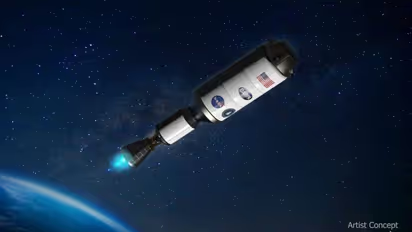NASA picks Lockheed Martin to build nuclear-powered rocket to reach Mars faster

Synopsis
Unlike traditional rocket engines, nuclear electric propulsion systems offer higher fuel efficiency and lower thrust. These systems could significantly reduce travel time to Mars and enhance crew safety during missions. The focus is on using a less-enriched form of uranium and activating the nuclear reactor only in space to minimize risks
US Space Agency NASA, in collaboration with the Defense Advanced Research Projects Agency (DARPA), announced on Wednesday the selection of Lockheed Martin to lead the design, construction, and testing of a nuclear rocket that could drastically reduce travel time to Mars compared to current spacecraft. The project, called DRACO (Demonstration Rocket for Agile Cislunar Operations), aims to launch a nuclear-powered rocket into space as early as 2027.
The primary objective behind the DRACO project is to significantly reduce the time it takes for humans to reach the Red Planet compared to the current spacecraft propulsion systems. At present, using traditional rocket engines, a journey to Mars takes between seven to nine months. These engines operate on combustion principles, propelling the spacecraft through space with limited fuel capacity and relatively low thrust.
However, the proposed nuclear electric propulsion systems are set to revolutionize space travel. While they also provide a low amount of thrust, they utilize propellants much more efficiently than chemical rockets.
Instead of relying solely on combustion, nuclear electric propulsion systems leverage the power of a reactor to generate electricity, which then positively charges gas propellants like xenon or krypton. The charged ions are expelled through a thruster, propelling the spacecraft forward. The result is a highly efficient system that can accelerate a spacecraft for extended periods, potentially reducing travel time to Mars by a significant margin.
The use of low thrust efficiently means that a Mars mission would require only a fraction of the propellant needed for high-thrust systems.
One of the key benefits of adopting nuclear thermal rockets is their potential to enhance crew safety during the mission. Limiting the time spent in space is crucial in minimizing radiation exposure for astronauts travelling to Mars. Moreover, the increased efficiency of these rockets would free up valuable space on the spacecraft, allowing for additional scientific equipment and instruments to aid in the mission's objectives.
NASA Deputy Administrator Pam Melroy highlighted the importance of collaborating with DARPA and commercial space industry companies to expedite the technology development required for sending humans to Mars. The DRACO project represents a significant milestone in NASA's ambitious plans for crew transportation into deep space and aligns with their overarching objective of paving the way for a manned mission to the Red Planet.
As the project progresses, the focus will be on utilizing a less-enriched form of uranium for the nuclear reactor. Additionally, the reactor will only be activated once the rocket is in space, minimizing any potential risks during its initial launch. If successful, the DRACO project could transform the future of space exploration, making human travel to Mars a realistic possibility within a more manageable timeframe.
Check the Breaking News Today and Latest News from across India and around the world. Stay updated with the latest World News and global developments from politics to economy and current affairs. Get in-depth coverage of China News, Europe News, Pakistan News, and South Asia News, along with top headlines from the UK and US. Follow expert analysis, international trends, and breaking updates from around the globe. Download the Asianet News Official App from the Android Play Store and iPhone App Store for accurate and timely news updates anytime, anywhere.